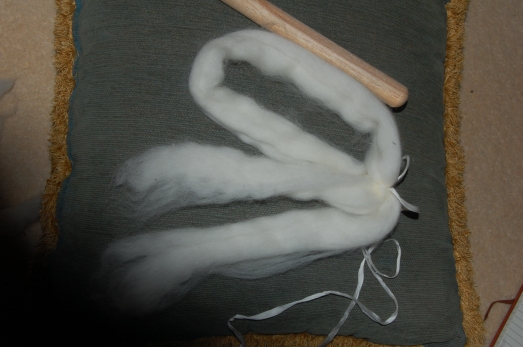I’ve asked this question once before in my entry What’s So Great About a Distaff but now I have a bit more spinning time with a distaff under my belt (do you see what I did there?) I feel I have more to say.
In my last entry I talk about how a distaff is great for spinning when you are active, watching flocks and going to the market. I wrote about how handy it was to have the fibre just THERE to grab and how you didn’t need to keep joining on more fibre unless you broke your thread.
What I’m finding the most beneficial now, however, is that using a distaff gives you another hand and it’s something I’d never had discovered without attempting to re-create the spinning methods used in the 15th century.
If you are drafting worsted (not letting the twist travel into the drafting zone) it is very useful. You have your right hand holding the spindle, your distaff holding the fibre, and your left hand pulling the fibre away from the distaff and stopping the twist from entering the drafting zone. Without a distaff your left hand would have to hold the fibre, draft it out and control the twist because your right hand is always at the spindle. With drop spinning you let go of the spindle and use both hands to do the drafting etc so it’s not so necessary to have a distaff.
With woolen drafting (when the twist enters the drafting zone) I find if I get things just right my left hand does very little work, I just use it to monitor how much fibre is getting pulled into the thread now and then. But again it’s nice to have the distaff to hold all that fibre and to provide something to pull against.
With drop spindle spinning you don’t have to worry about that other hand. You set that spindle in motion then you’ve got two hands to handle the drafting and holding the fibre. With the style of spinning used in the 15th century you have one hand constantly at the spindle so you really need that distaff.
In short, a distaff isn’t just to hold fibre, it plays an integral part in the spinning technique.
My distaff is still just a broomstick. It would be great to at least have a nob on top to tie my ribbons around but I eventually want one with a small cone on top.
For now I’ve been using commercially prepared wool. I’ve just been laying lengths over the top of my stick , tying them tight at the top, crossing ribbon down the length and tying in a loose bow. It works well and I can move the ties up as I go.
I had a go at dressing a distaff for more woolen spinning. I carded some of my wool into bats. I then laid the bats out and wrapped them around my distaff and tied with a ribbon. Seemed to work quite well though I haven’t spun much from it (and I only used a tiny amount of wool).







I’m forever telling people a distaff improves your spinning, but no one ever listens
I just don’t think I could spin without one! Not properly anyway. Maybe a few feet just to test out some new fibre but actual production spinning? Not with the method I’m using! Distaff is a must have. Shame folks don’t listen to you, but I guess it’s their loss?
I agree about the distaff. Apart from all the reasons you give, on a hot day any wool held in the hand is going to very quickly turn into felt!